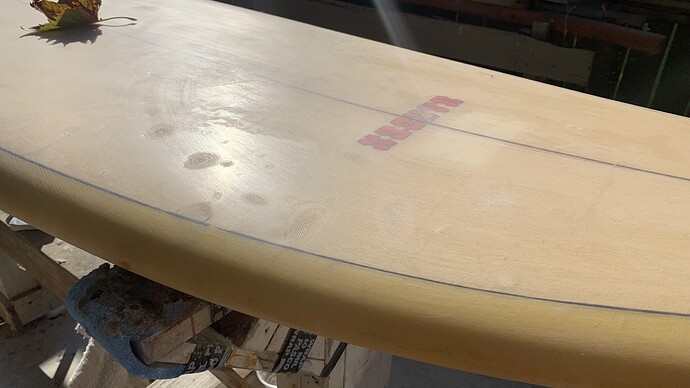So the thing about repairing / restoring an old board like this is that there is no clear cut plan of attack A-Z, its really just a myriad of little decisions, constantly revised as you progress, judgement calls, gut feelings, and whim of the moment. For that reason, I think it would always be a labor of love, you couldn’t charge enough money to pay for all the time spent analyzing, doing and re-doing, patching, blending, sanding, over and over as you progress, until you get to a point you say OK, that’s it, I’m calling it done.
At least for me its always that way. I patched a bunch of dings and dents, added a layer of tinted resin to the rails, painted some pin lines, coated everything with a layer of resin, then decided there were more (smaller) little dents I wanted to fill in. More resin work with little ovals of fiberglass all over (I tried to show that in a couple pics), more sanding, sanded through the rail tint and the pin lines in several places, put another very thin coat of resin over everything.
My goal was to repair the bottom to the point of no dents, or at least almost no dents, to fill the big dents on the deck, but allow for some dimpling and denting representative of a 55 year old board that was loved and surfed in its day. I added a deck patch, meaning I glassed over about 70% of the deck, and then filled in most the dents on the nose.
I decided no opaque resin covering over repairs, I always cringe at “restored” old boards all covered in bright new opaque resin, with a clear deck showing old yellowed foam, it always just looks wrong to me. But its a judgement call, no right or wrong way to do it.
I tried to be respectful of the age and history of the board, while making a few changes to make it surfable and maybe a bit more aesthetic. I added yellow tint to the rails. The pinline on the deck was always there, but I added a pinline on the bottom.
I built up the rounded rail in the tail to allow a bit more of an edge in the fin area. It doesn’t look great, and its a change from the original, but it was a compromise that I felt wasn’t out of character from something that might have been done to the original back in the day, and hopefully will make it a bit more rideable.
I made two new fins, one using the old plastic fin as a core (so I could utilize the unique base to fit the box). In doing so, I destroyed the old original fin, which was cheap plastic, a bit deformed, and an ugly and impractial looking shape. But for some, they would have kept the original in original condition. So I’m not a hardcore purist. I removed the ugly leash plug that was there when I got it, and added a leash loop of wood. Clearly not original.
Now I think I’m going to re-tint the rails after sanding through the tint in several spots, then re-do the pinlines in resin, then a layer of clear over everything and polish up. Hopefully it goes as smooth as that sounds, but there’s always a chance I will decide to do something a little different as it nears completion. (All my work has been with epoxy resin, as I do not work with polyester resin anymore.)
Good thing these are not billable hours, I’d get fired.

















